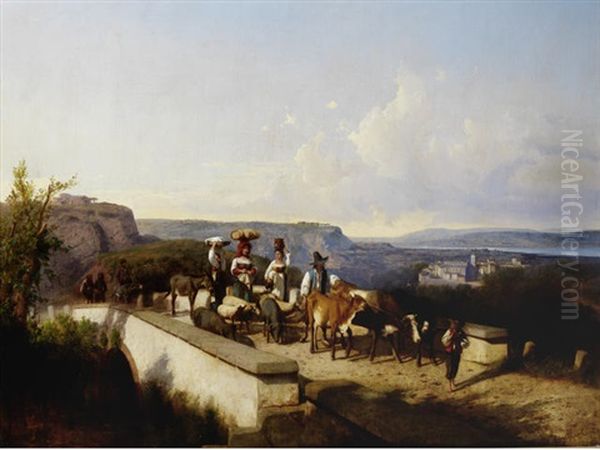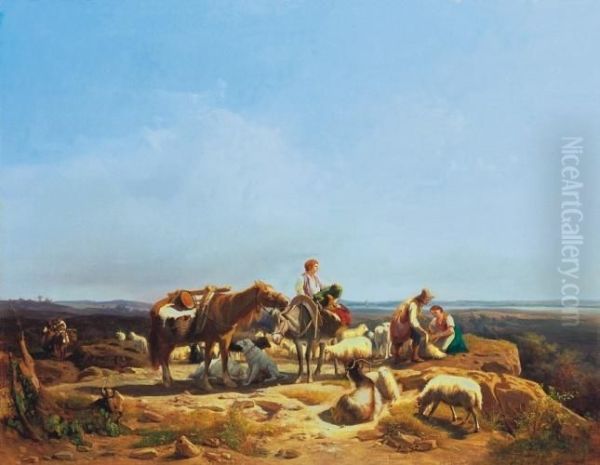András Markó, a significant figure within a notable family of artists, navigated the European art world of the 19th century, leaving behind a body of work deeply rooted in the Romantic landscape tradition. Born in 1824 and passing away in 1895, his life and career bridged different cultural centers, primarily Hungary and Italy, reflecting the cosmopolitan nature of artistic pursuits during his era. While perhaps less internationally renowned than his father, his contributions form an important chapter in the story of Hungarian and Italian landscape painting.
The Markó Artistic Dynasty
Understanding András Markó requires acknowledging the formidable artistic legacy of his family. He was the son of Károly Markó the Elder (1791–1860), often referred to as Carlo Marko, one of the most celebrated Hungarian landscape painters of the Romantic period. Károly the Elder achieved significant fame, working for patrons across Europe and eventually settling in Italy, near Florence. His style, characterized by idealized, classically inspired landscapes bathed in warm, atmospheric light, drew heavily from masters like Claude Lorrain and Nicolas Poussin, yet infused with a Romantic sensibility.
This artistic environment profoundly shaped András and his siblings. Several of Károly the Elder's children also became painters, including Károly Markó the Younger (Carlo Marko the Younger, 1822–1891), Ferenc Markó (Francesco Marko, 1832–1874), and Katalin Markó (1838-1881). They often worked in styles similar to their father's, creating a veritable Markó school of landscape painting centered around their Italian base. András, therefore, grew up immersed in the techniques, aesthetics, and professional networks of landscape art.
Early Life and Artistic Formation
András Markó was born in Pest (now part of Budapest), Hungary, in 1824. His early artistic education inevitably took place under the direct tutelage of his highly successful father. The Markó family's life was somewhat peripatetic due to Károly the Elder's career, but Italy, particularly Florence and its surroundings, became their adopted home and the primary locus of their artistic activities from the 1830s onwards.

While specific details about András's formal training beyond his father's studio are sometimes debated, it's clear his development was steeped in the classical-romantic landscape tradition. He would have learned the meticulous techniques required for detailed rendering of foliage, rocks, and water, the principles of compositional harmony derived from classical examples, and the methods for achieving evocative effects of light and atmosphere that were hallmarks of his father's work. Some sources suggest studies at the Vienna Academy, a plausible step given the family's connections within the Austro-Hungarian sphere, but his primary artistic identity was forged in Italy.
Flourishing in Florence: Style and Themes
András Markó spent a significant portion of his productive life in Italy, primarily based near Florence, living and working in the Villa Appeggi, which his father had acquired. He became an active participant in the Florentine art scene. His style closely followed the path laid by his father, focusing on idealized Italianate landscapes. These scenes often featured rolling hills, serene lakes or rivers, picturesque ruins, castles, and small figures – typically peasants, shepherds, or travelers – that added narrative interest and scale but remained subordinate to the grandeur of nature.
His works exemplify the later phase of Romantic landscape painting, which retained a deep appreciation for nature's beauty but often presented it through a structured, harmonious lens inherited from the classical tradition. Unlike the more dramatic or sublime visions of nature found in artists like Caspar David Friedrich or J.M.W. Turner, András Markó's landscapes generally evoke a sense of peace, nostalgia, and idyllic charm. The influence of 17th-century masters like Claude Lorrain remained palpable in the careful composition and the treatment of light, often depicting the warm glow of sunrise or sunset.
While closely aligned with his father's style, some observers note subtle differences in András's work. His handling might occasionally appear slightly looser or more naturalistic than the highly polished finish of his father's peak period. However, he remained committed to the established Markó aesthetic, finding a ready market among collectors who appreciated these beautifully crafted, evocative visions of Italy. His subject matter frequently revolved around the Roman Campagna, the Tuscan countryside, and coastal views, often populated with pastoral figures.
Representative Works
Attributing specific works definitively within the Markó family can sometimes be challenging due to stylistic similarities and shared studio practices. However, several paintings are consistently associated with András Markó and exemplify his artistic output.

One notable example is _Italian Landscape with Bridge and Figures_. This type of composition is characteristic, featuring a carefully constructed scene with a stone bridge arching over a gentle river, framed by lush trees and distant hills. Small figures animate the scene, perhaps conversing or resting, adding a touch of human life to the tranquil natural setting. The rendering of light and atmosphere would typically be soft and inviting, emphasizing the idyllic quality of the Italian countryside.
Another work often attributed to him is _Returning Peasant Family with Goats_ (dated circa 1870). This painting depicts a common theme in pastoral landscapes: a family guiding their small herd home, likely at dusk. The scene combines detailed observation of the figures and animals with an idealized landscape setting, bathed in the warm, golden light typical of the Markó style. It speaks to the Romantic era's appreciation for rural life, seen through a somewhat sentimentalized lens.
Paintings titled _Cows_ or featuring cattle prominently also appear in his oeuvre, reflecting the importance of pastoral elements. Similarly, works like _View of the Carrara Marble Mountains_ showcase his ability to handle more specific topographical subjects while still imbuing them with atmospheric beauty. Biblical scenes, such as _Ruth and Boaz_, demonstrate his capacity to work within historical or religious genres, placing narrative figures within expansive landscape settings, a practice common since the Renaissance and Baroque periods, revitalized by Romantic painters.
These works collectively showcase András Markó's adherence to the family style: meticulous technique, balanced compositions, warm lighting, idealized Italian scenery, and the inclusion of small-scale figures to enhance the pastoral or narrative mood.
Exhibitions and Recognition
András Markó actively exhibited his work, particularly during the mid-19th century. Records indicate his participation in exhibitions in Florence, where he was associated with the local artistic community. He also maintained connections with his homeland, reportedly exhibiting with the Hungarian National Fine Arts Association (Országos Magyar Képzőművészeti Társulat) in Pest during the 1850s. This suggests an effort to cultivate patronage and recognition in both his native and adopted countries.
Being part of the Markó family undoubtedly provided him with access and a degree of reflected prestige. His works were acquired by collectors who admired the established Markó brand of landscape painting. While he may not have achieved the same level of individual fame or innovation as his father, he sustained a successful career as a professional artist, contributing to the enduring popularity of the Romantic landscape genre throughout the latter half of the 19th century.
Context within 19th-Century Landscape Painting

András Markó's career unfolded during a period of significant evolution in landscape painting. While he remained largely faithful to the classical-romantic tradition established by his father, the broader art world saw the rise of Realism and, later, Impressionism. In France, the Barbizon School painters like Camille Corot and Théodore Rousseau were exploring more direct, naturalistic depictions of landscapes, often painted outdoors (en plein air). In Italy itself, the Macchiaioli group, including artists like Giovanni Fattori, were experimenting with capturing light and form through patches ('macchie') of color, moving towards a more modern sensibility.
Compared to these movements, András Markó's work appears more conservative, upholding the values of idealized beauty, careful finish, and studio-based composition. His contemporaries in Hungary included figures like Miklós Barabás, known for portraiture and genre scenes but also landscapes, and later, the more dramatic historical and landscape painter Mihály Munkácsy, whose style was considerably different. Károly Lotz also contributed to Hungarian painting during this era.
András Markó's adherence to the established Markó style placed him closer to artists who continued the traditions of idealized landscape, perhaps akin to some aspects of the German Romantic tradition represented by figures like Carl Rottmann or the lingering influence of the School of Posillipo in Naples, known for picturesque views by artists such as Giacinto Gigante, though the Markó style was generally more classically structured. His work represents the persistence of a highly refined, internationally appreciated form of Romantic landscape even as newer, more radical approaches were emerging elsewhere.
Later Life and Legacy
András Markó continued to paint, based primarily in Italy, until his death in 1895 in Villa Appeggi, near Florence. He outlived his father and most of his artist siblings, carrying the family's artistic tradition into the final years of the 19th century.
His legacy is intertwined with that of his father and the Markó dynasty as a whole. As a skilled practitioner of the family style, he helped perpetuate a specific vision of Romantic landscape painting that found favor with international audiences for decades. His works are held in various public and private collections, particularly in Hungary and Italy, and occasionally appear on the art market, appreciated for their technical skill and nostalgic charm.
While art history often focuses on innovators, artists like András Markó play a crucial role in understanding the depth and persistence of established traditions. He represents the dedicated continuation of a successful artistic formula, providing beautifully crafted works that catered to the tastes of his time. His paintings offer valuable insights into the later stages of Romantic landscape painting and the dynamics of artistic families in the 19th century. He remains a respected figure within the history of Hungarian art and the broader context of European landscape painting. His connection to Italy, alongside his Hungarian roots, highlights the transnational networks that characterized the art world of his era, linking artists like Antonio Fontanesi in Italy with broader European trends.